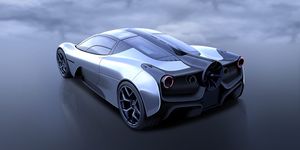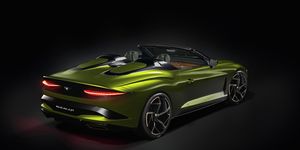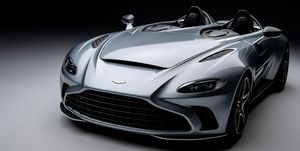Is anyone else feeling a warm nostalgia for the days when it was cars, rather than non-bacterial pathogens, trying to kill us? I’m not talking about those that were poorly maintained or inexpertly modified. Bald tires, friction-free brakes and ill-advised suspension modifications have taken many to a fatal appointment with point X on police accident reports. But those statistics are on the owners, not the cars. Nope, I’m talking about those vehicles that left the factory with a taste for blood, born under a bad sign with a blue moon in their eyes. I’m talking about the widowmakers.
The expression is much older than the automobile. But it saw a major resurgence with the birth of the airplane – pretty much the first 30 years of flight was all widowmaker. In Europe, automotive use is largely drawn from the direct German translation, witwenmacher, which was first applied to the Cold War–era Lockheed F-104 Starfighter. This supersonic jet interceptor had what looked like impossibly tiny wings and a corresponding lack of stability. More than a quarter of the German Luftwaffe’s fleet were lost in crashes, killing 115 aircrew and earning the witwenmacher name in the media’s frequent accident reports. When increasingly fast versions of the Porsche 911—especially the 930 Turbo—demonstrated a similar knack for killing low-flying test pilots, the term transferred across, and the legend was reborn.
Regardless of label there have always been vehicles that, compared to their peer group, enjoy an enhanced level of crashability. But true widowmakers are a necessarily small elite. Definites on the list? The early Shelby Cobra is a must, thanks to the combination of a chassis with only marginally more torsional rigidity than liquorice and a leaf-sprung rear axle largely unable to deal with an output twice as high as the original AC Ace had been designed for. The Porsche 930 Turbo’s credentials are also hard to dispute, especially given the limited ability of mid-70s tire technology to deal with the engine’s gusty power delivery and the car’s thrown-hammer weight distribution. More recently the early, non-ABS Dodge Viper is a strong contender for the title, although not in the class of the Porsche Carrera GT, a car involved in several high-profile high-speed wrecks, including the one that claimed the life of Paul Walker back in 2013.
I never got to put my head into the teeth-filled mouths of any of these famous hellions, but I do feel a strong affinity for the genre thanks to the effort of just one company: TVR.
As you can probably tell from my accent, I’m British. Which, beyond an appreciation for tea with milk and the arcane rules of cricket means I also come from the country that got to experience raw, unfettered, and nanny-free cars for longer than practically anywhere else. And while the UK’s low-volume sports-car–makers have traditionally favored handling precision over outright power, TVR pretty much reversed the equation.
When I started writing about cars in the late 1990s, the brand was enjoying a renaissance under the leadership of Peter Wheeler, a former industrial chemist who had spent some of his self-made fortune buying the company and turning it to the creation of what can only fairly be described as a spectacular series of widowmakers. While other British low-volume makers were turning out either sportscars old-fashioned enough to have timbered mullions or the sort of light-weight creations that looked like scaffolding accidents, Wheeler willed (and spent) into being a range of handsome, muscular cars with names as macho as ‘80s cologne fragrances: Griffith, Chimera, Cerbera, Tuscan.
The swoopy designs came from fiberglass bodywork hung over steel chassis, minimizing weight. Power initially came from Rover-sourced V-8s and then, once these proved insufficiently potent, from a range of straight-sixes and V-8s TVR developed itself. None of these home-grown mills proved very reliable, but when working all were hugely powerful, with the ultimate incarnation of TVR’s naturally aspirated 4.5-litre V-8 making 450 horsepower when the contemporary 911 Turbo required two compressors to reach a similar output.
Weighing less than 2500 pounds, TVRs were hugely fast. One UK magazine ran a Cerbera 4.5 from 0 to 60 mph in 4.1 seconds, and from rest to 100 in 8.9. Both figures are within a tenth of the times it extracted from the Ferrari 360. This in a car that cost less than a base Porsche 911 at the time and produced by a company without the engineering pedigree of either brand.
But beyond straight lines, TVRs were frequently terrifying. Wheeler didn’t believe in the complexity (or cost) of electronic aids, so TVRs didn’t have traction control or even anti-lock brakes. Build quality was similarly hit-and-miss, reflecting the construction techniques employed by the Blackpool factory. It was unusual to return any TVR after a press loan without having to report that something had broken or fallen off.
Trying to drive any TVR hard was like baiting an angry bull. They could be persuaded to travel quickly in corners, but rapid progress would come with chassis flex and sometimes vicious steering kickback. It was easy to inadvertently engender lurid angles of oversteer with the throttle, but also with the brake pedal, something I found out in an early Tuscan when I realized the rear wheels would lock before the fronts, giving a similar experience to pulling the e-brake at speed. Drives would often end with a sheen of terror-induced sweat clinging to the seat leather.
They were equal parts terrifying and awesome, yet despite driving at least one example of every TVR model built between 1998 and the company’s demise in 2006, I never crashed one. The risk was so obvious, the consequences of pushing so unambiguous. But nothing makes you feel more alive than the imminent risk of no longer being. The prettiest flowers really are the ones that grow closest to the edge of the cliff. Maybe when this madness is all over, we need some more widowmakers.
Source: Motor - aranddriver.com









